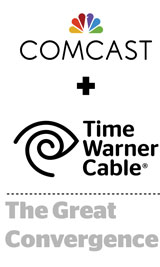By Ryan Joe and Judith Aquino
Media and cable conglomerate Comcast Corporation’s $45 billion deal to acquire its peer, Time Warner Cable, could be a boon for the advertising and marketing industry, combining Comcast’s superior digital platforms with Time Warner Cable’s audience reach across major metropolitan markets.
“[This will provide] a level of scale and data insights that will be unsurpassed in the US TV industry,” said Russell Marsh, chief global data officer at Interpublic Group’s Mediabrands. “New data generated from this will provide huge insights across the whole country in terms of content consumption and of course what advertising is ultimately seen.”
In a public interest benefits summary filed by Comcast, the company wrote that it “has already completed its transition to an all-digital platform.” In contrast, the statement also noted Time Warner Cable’s all-digital migration is only 17% complete. One of the major initiatives derived from Comcast’s digital maturity is its “TV Everywhere” system, through which consumers can access TV shows and media through Internet-connected mobile devices.
But Time Warner Cable, with presence in major media markets like Dallas, Los Angeles and parts of New York City, has access to a valuable audience closed off to Comcast. This is largely due to the way the cable industry is set up, in which network footprints don’t overlap.
If approved, the cable merger could be a catalyst for more sophisticated data-driven TV advertising, said Dave Morgan, CEO and founder of Simulmedia, which helps advertisers target TV audiences.
“Cable distribution companies have been trying for years to make ads more targetable through piecemeal investments but they’ve been held back by scale and fragmentation issues,” Morgan said. “With more scale, the combined Comcast and Time Warner Cable ad sales efforts will have more incentive and resources to invest in both data-driven and addressable systems and products.”
The combined household data from Time Warner Cable and Comcast could generate more detailed household segments in which each member receives certain offers or hyperlocal ads. “With more data, [Time Warner and Comcast] will be able to cherry-pick the households that they want to deliver offers to,” Morgan said.
Amir Ashkenazi, CEO and founder of the video advertising-tech company Adap.TV, theorized that the deal could increase the data pool used to feed the “NBCU+ Powered By Comcast” targeting initiative that Comcast unveiled last month. This is a platform from Comcast and its subsidiary NBCUniversal designed to sell targeted ads to video-on-demand users, in addition to offering viewer insights collected from anonymized subscriber set-top box data.
“Advertisers will see more value in the expanded audience data and will be able to better align their brands with particular shows,” Ashkenazi said. “In the long run, this [merger] will propel forward data-driven audience buying for TV.”
So on the surface, the potential acquisition (which will need to endure an extended regulatory review process) seems rosy. But as IDC’s research manager of multiscreen video, Greg Ireland, points out, TV advertising is still experiencing growing pains that this acquisition won’t immediately remedy.
Brands, for instance, are still figuring out the extent to which they can (or want to) transition from buying advertising on communal, far-reaching devices like television to leveraging opportunities on personal devices like mobile phones or tablets, which present the possibilities for one-to-one marketing.
Certainly the paid TV environment that includes Comcast, Time Warner Cable, DirecTV, DISH and AT&T’s U-Verse is beginning to straddle this divide.
“There’s now a diversity of consumption platforms associated with paid TV that is beginning to mirror the traditional Web environment,” Ireland said. This shift, however, is ongoing, and there are still unresolved issues around how audiences are measured and how ratings tools – like those supplied by Nielsen – can be applied in an online environment.
But while the Web industry has worked quickly to develop tools to measure online ad viewability and engagement, the paid TV industry has been much slower. Part of this is because while the paid TV industry is beginning to see competition from innovative online video services like Netflix, Hulu and Amazon, they’re still fundamentally competing with each other (after all, the era of rampant cord cutting is still a few years away). “They’re all working toward developing multiscreen applications and services,” Ireland said, “but the paid TV industry is not typically as nimble as the Web industry.”
And Ireland isn’t certain if Comcast’s acquisition will necessarily expedite development of tools advertisers can use. Content providers like Disney, A&E and ESPN determine how they distribute their shows – whether it’s through an online portal or through paid TV (and advertising dollars can’t flow without good content oiling the pipes). Comcast, by dint of owning NBCUniversal, is also a content provider. “While they’re moving forward in the technology and getting multiscreen services out there, there’s a gatekeeper role they get to play on how widely their content is distributed to nontraditional competitors, which could inhibit more rapid competition-driven innovation,” Ireland said.
On the flip side, Simulmedia’s Morgan anticipates the union between Time Warner Cable and Comcast will create an environment that spurs ad-tech advancements.
“Cable networks have two main revenue streams: They get money from distributors and money from advertising,” he said. “Having more scale on the distributor side will mean that cable networks will see more pressure on their carriage fees [and so] they will have to make more money through advertising, which means we’ll probably see cable networks also investing in more technology and data to maximize the pricing of the ads they sell.”














